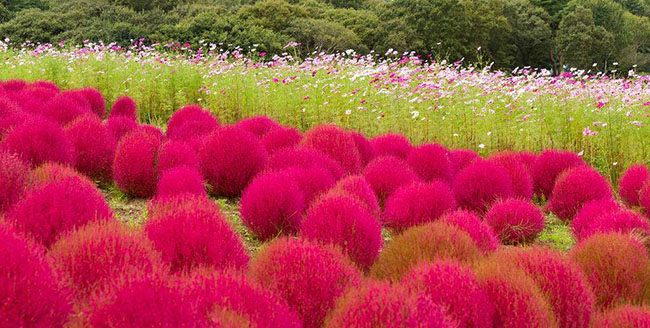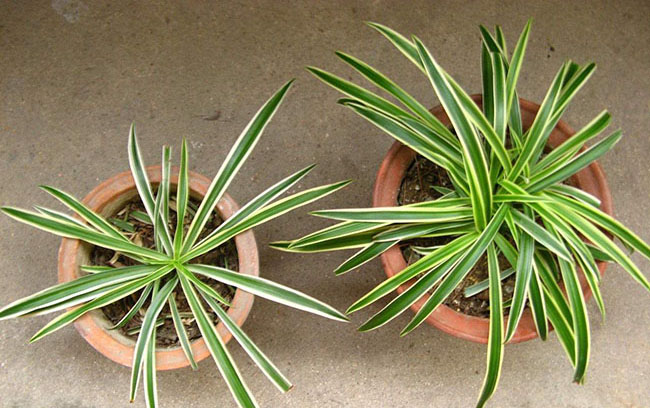The efficacy and Culture methods of Fructus Corydalis
Encyclopedia of skin
The plant cluster is compact, the plant shape is oval to spherical, Obovate or oval, many and thin branches, pubescent, stem base semi-Lignification. Stems have many branches, leaves linear-lanceolate, simple leaves alternate, leaves linear, linear or strip-shaped. Spikes with small reddish-brown flowers, tiny flowers, no ornamental value, utricles oblate. The plant is tender green and the leaves turn red in autumn. The fruit is oblate and can be used as medicine, which is called Fructus Rehmanniae. Young stems and leaves can be eaten, and old plants can be used as brooms.
Skin growth habit
Skin adaptability is strong, like temperature, light, drought resistance, not cold-resistant, soil requirements are not strict, more alkali-resistant soil. Fertile, loose, humus-rich loam is conducive to the exuberant growth of the soil.

A variety of the skin of the earth
Kochia soda
The difference between this variety and the original variety is that there are dense bunches of rust-colored pilose under the flowers.
Kochia soda
Produced in Heilongjiang, Jilin, Liaoning, Inner Mongolia, Hebei, Shanxi, Shaanxi, Gansu, Ningxia, Qinghai, *. Born in gully wetlands, beaches, roadsides, seashore and other places.
Broom vegetable
Broom vegetables have many branches, the plants are ovate or Obovate, and the leaves are narrow. Cultivated as a broom. The branches and leaves turn red in late autumn for viewing
Cultivation techniques of Cortex Rehmanniae
Skin seedling
The adaptability of the skin is strong, it can be planted in all parts of the north and south, and the soil requirements are not strict. It can be planted in front of the house, behind the house, at the edge of the ground, and at the corner of the ground. Propagate with seeds and sow in April in spring. Watering thoroughly before sowing, strip sowing, row spacing 0. 5-0. 8m, covering soil 0. 4cm-0. 5cm, sowing rate 1kg/667m2, and slightly suppressing after sowing. Keep the soil moist and emerge in about 10 days. After the seedlings come out, it is necessary to have time for seedlings, set seedlings, loosen the soil and weed in time, water at the right time, and apply topdressing 2-3 times a year. When the fruit is ripe in autumn, cut the whole grass, dry and lay down the fruit, remove impurities and set aside. The stems and leaves can be cut and dried in the sun.
Sowing and raising seedlings
The suitable germination temperature is 10-20 ℃. The method of direct seeding on bare ground or seedling transplanting in protected field can be used when raising seedlings. A naked live broadcast can be held in mid-late April. Hole sowing, strip sowing and sowing can be done. The seedlings in the protected area can be sowed in the first ten days of March to the middle of March. Although the soil is more drought-resistant and has lax requirements on the soil, it is necessary to irrigate enough water and apply a certain amount of rotten heat organic fertilizer before sowing. The thickness of soil cover is 1-1.5 cm.
Field management
Fix or transfer seedlings. If the bare ground direct seeding is used, when the seedlings grow to 15-20 cm high, the seedlings can be fixed according to the row spacing of 70-100 cm; if the seedlings are raised in protected areas, the seedlings can be transferred and planted when the seedlings grow to 6-10 cm.
Water and fertilizer management
In addition to applying sufficient base fertilizer, 150kg/hm2, an instant bio-organic fertilizer, was applied in combination with irrigation during seedling thinning and slow seedling thinning. Although the skin is more resistant to drought, keeping the field moist can not only increase the yield, but also improve the quality of its products. Therefore, water should be watered every 7-10 days during the growing period.
Timely harvest
Generally, when the plant grows to 15-20 cm high, the seedlings can be harvested, the stems and leaves can be harvested one after another from April to July, and the whole plant or seeds can be harvested after autumn.
Pest control
The ground skin is vulnerable to aphids and can be controlled with 1000-1200 times of dimethoate EC. The skin is also easy to be parasitized by dodder, so the weeds should be removed in time after discovery.
The main control methods of farmland weeds are artificial control, chemical control, mechanical control, alternative control and ecological control. Using the principles of covering and shading, weeding is carried out by covering or sowing other crops (or grass seeds) with plastic film.
Artificial control of ①
First of all, the artificial control of weed seeds into the field is to prevent weed seeds or reproductive organs from entering the crop field as far as possible, remove weeds on the side of the ground and along the road, strictly enforce the weed quarantine system, and select sowing materials. special attention should be paid to weeds that have not been or have not been widely spread in China must be strictly prohibited or strictly controlled to prevent them from spreading so as to reduce the sources of weeds in the field. When making farm manure with weeds, the fertilizer containing weed seeds should be covered with film, compost at high temperature for 2-4 weeks, decompose into organic fertilizer, kill its germination power and then use it.
Artificial weeding combined with agricultural activities, such as direct manual uprooting or eradication after weed germination or growth period, or combined with farming measures such as ploughing and fertilization to remove weeds.
② mechanical prevention and cure
Combined with agricultural activities, various measures such as ploughing, raking, ploughing and loosening soil are carried out by using agricultural machinery or big-sky agricultural machinery to weed before sowing, before emergence and at different growth stages, and to kill, cut or eradicate weeds directly.
Chemical control of ③
The main feature is efficient, labor-saving, eliminating the heavy field weeding work. There are more than 300 kinds of chemical herbicides at home and abroad, and different dosage forms of preparations have been processed, which can be used for the main value of herbicide in almost all food crops and cash crops.
The medicine land skin son function mainly treats the benefit urination, clears dampness and heat. Treatment of adverse urination, gonorrhea, belt, hernia, rubella, sores, scabies, vaginal itching.
① "Ben Jing": the main bladder is hot and facilitates urination. Tonifying the middle and tonifying vital energy.
② "don't record": remove heat in the skin, disperse bad sores, hernia, strengthen yin, make people moist.
③ "theory of drug properties": with Yangqi stone, the main husband can not afford impotence, tonifying qi and tonifying strength; treat Yin egg disease, go to hot wind, can be used as soup bath.
④ "Rihuazi Materia Medica": to treat fever and swelling.
⑤ "Southern Yunnan Materia Medica": help bladder urine accumulate heat, wash skin wind, cure women's classics fever, clear febrile fever, damp tropical zone
⑥ "Materia Medica primitive": remove heat in the skin, wet and itchy except the skin.
⑦ "Materia Medica preparation": tonifying essence and strengthening yin, eliminating deficiency and heat, promoting urination and purging diarrhea.
⑧ "Jade Juglans mandshurica solution": treat head swelling and pain, fox hernia and Yin decay, low back pain, blood dysentery, malignant sores.
The skin seedling attached prescription
① treatment: two or seven handfuls of skin grass, fried with two liters of water. You can also wear long clothes. ("Fan Wang Fang")
② treatment of a large number of urine, or hot pain, hands and feet pain: skin grass three taels, four liters of water, boiled two and a half liters, divided into three servings. ("Milk production set Test prescription")
③ treats the eyes injured by objects, or meat cuttings: five taels of raw skin seedlings, clean wash, tamper to extract juice, porcelain box in the Sheng, with copper oysters frequently in the eye. If the winter moon is dry, boil the juice and point it. ("Sheng Hui Fang")
Pharmacological function of Fructus Rehmanniae
① bacteriostasis:
The water extract has an inhibitory effect on dermatophytes such as Trichophyton Xu and Trichophyton angustifolia in the test tube at 1:3. By test tube dilution method, the aqueous extract had inhibitory effect on Xanthophytes xanthophyllum, Microsporum Audulonum and Nucaca stellata at 1:3. The bacteriostatic agent used as water extract at 1:3 had different bacteriostatic effects on dermatophytes such as Trichophyton Xu, Trichophyton Auduoni, Trichophyton ferruginum, Trichophyton woolly and other skin fungi in the test tube. 50% of the decoction had a weak inhibitory effect on Salmonella typhimurium by dry plate trenching method.
② suppresses allergies:
③ ornamental value
Garden uses: flower beds, flower borders, flower bushes, flower groups
The Medicinal and Edible effects of Fructus Rehmanniae
Skin can facilitate urination, clear damp-heat, treat adverse urination, hernia, sore poison, gonorrhea, rubella, scabies and other diseases.
The skin of the earth is edible
The skin is also edible, mainly eating its tender stems and leaves, blanching with boiling water, cold salad, stir-frying or stuffing. Fried meat with ground skin is a fresh and delicious dish with full flavor.
The above is the role of the skin, its role is really a lot, I hope everyone can carefully take care of their own skin, raised out, but surprise again and again!
Culture methods and matters needing attention of skin
The culture method of skin, soil.
Skin does not have high requirements for soil, like loose, fertile, humus-containing sandy soil, and good drainage of sandy soil, but can also tolerate barren and thin soil, can also tolerate alkali soil.
Light and temperature
The skin likes the sunny environment, but it is also a more shade-tolerant plant.
In terms of temperature, the skin likes to be warm and is not resistant to cold. In addition, the suitable temperature for skin germination is between 10 and 20 ℃.
Water and fertilizer management
In the aspect of water and fertilizer management, the maintenance and management of land skin is still very simple and extensive. Basically, when planting, the soil needs to be fertilized with a certain amount of base fertilizer and watered once.
After planting, you need to apply fertilizer 2-3 times a year for the skin, of course, you can no longer apply fertilizer. Watering, although the skin can withstand drought, but still should add a certain amount of moisture, moisturizing the soil, the skin will grow well. Water is required to be watered every 7-10 days during the growing period. The soil is dry and wet to avoid stagnant water.
Reproduction method
The reproduction of Kochia mandshurica is generally sown and propagated, which is generally carried out in spring and sowed directly. The seeds of Kochia mandshurica are sown in April every year, and before sowing, base fertilizer is applied to keep the soil moist. Seedlings can emerge in about 10 days, and can be planted at the right time. The sowing and propagation of the skin is rapid, neat and easy to maintain.
Matters needing attention in the culture of the skin, weeds
In the growth process of the skin, it is inevitable that there will be a lot of weeds, which need to be removed. Weeding can be carried out by means of artificial control, mechanical control, chemical control, alternative control and ecological control.
Diseases and insect pests
The skin is more vulnerable to aphids and the parasitism of dodder. It needs timely prevention and control.
- Prev

What is the function of lavender? Planting method of lavender
Lavender. The British have always regarded lavender as a symbol of purity, purity, protection, gratitude and peace. The hometown of lavender is in France and Hokkaido in Japan.
- Next

Culture methods and matters needing attention of Cymbidium sinensis
Morphological characteristics of Magnolia lanceolata, also known as Cymbidium, is a perennial herb with clustered cylindrical fleshy roots and short rhizomes. Leaves basal, striate to long lanceolate, entire or slightly undulate, scape drawn from leaf axils, long 30~50cm, curved and drooping to form new stolons. raceme
Related
- Fuxing push coffee new agricultural production and marketing class: lack of small-scale processing plants
- Jujube rice field leisure farm deep ploughing Yilan for five years to create a space for organic food and play
- Nongyu Farm-A trial of organic papaya for brave women with advanced technology
- Four points for attention in the prevention and control of diseases and insect pests of edible fungi
- How to add nutrient solution to Edible Fungi
- Is there any good way to control edible fungus mites?
- Open Inoculation Technology of Edible Fungi
- Is there any clever way to use fertilizer for edible fungus in winter?
- What agents are used to kill the pathogens of edible fungi in the mushroom shed?
- Rapid drying of Edible Fungi

